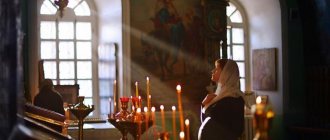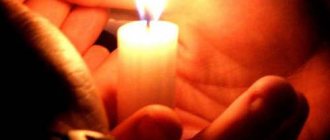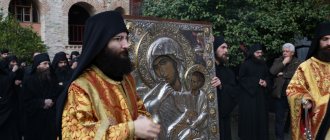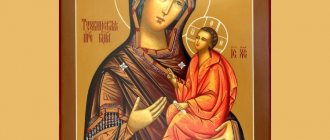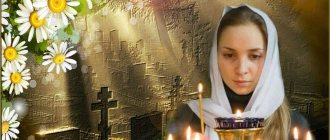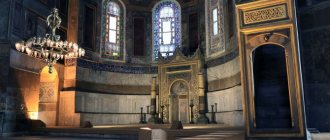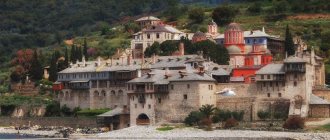Kykkos Icon of the Mother of God. XVII century 1668 Icon painting school: Armory Chamber. Icon painter: Ushakov Simon (Pimen) Fedorovich. Origin: from the local row of the main iconostasis of the Church of St. Gregory of Neocaesarea on Bolshaya Polyanka in Moscow. Material; wood, tempera. Dimensions of the icon: height 130 cm, width 76 cm. The icon is one of the copies of the ancient miraculous icon of the Mother of God from the island of Cyprus, located in the monastery on Mount Kykkos. The inscription-title of the icon of Eleus Kikkotissa is written in Greek. Inv. No. 28691. State Tretyakov Gallery, Moscow
Cypriots call this image of the Mother of God, extraordinary in its beauty, “Kikkiotis”. This engraving was made back in the 16th century on a silver chasuble with gilding. In Russia, the icon is called “Kykkos” or “Merciful-Kykkos”. such an unusual name for Russian ears from the men's monastery located on Mount Kokkos or Kykkos Fr. Cyprus .
Description and meaning
The iconography of the “Kykkos” image is very interesting. It shows the Queen of Heaven praying to our Lord Jesus Christ for the salvation of Christians. On ancient lists the Mother of God is depicted from the waist up. With her face She touches the head of the Infant Christ sitting on her left hand.
Useful materials
This feature speaks of the boundless love of the Mother of God and the Infant. The Savior is presented in an unusual, as if playing, pose: it seems as if his open legs are taking steps. His left hand is hidden in the fold of the maforia, and in his right hand there is a scroll.
Caption for the icon:
Nimbus On the halo of the Mother of God are written the words from the akathist to the Most Holy Theotokos: “Rejoice, Unbrided Bride.” This is a poetic interpretation of Archangel Gabriel’s greeting during the Annunciation: “Hail, full of grace” (Luke 1:28).
Three stars Three stars are a symbol of the Holy Trinity, as well as symbols of the virginity of the Virgin Mary.
Crown The crown on the head of the Virgin Mary is a symbol of the Queen of Heaven. This is how believers often turn to the Virgin Mary.
Folded Hands Folded hands, bowed head and downcast gaze depict submission to the will of God.
HaloThree StarsCrownFolded Hands
Story
The story is amazing and mysterious. We first learn about him from the story “The Tale of Three Icons Written by St. Luke, where each of them is located, and the icon of the Mother of God, called Kykkos, which is located in Cyprus” by the 125-year-old hieromonk Gregory, resident of the Kykkos monastery. Date of creation: 1422.
In the Orthodox capital
The narrative begins with the creation by the Apostle Luke, guided by the Archangel Gabriel, of three iconographic images of the Mother of God, blessed by the Mother of God Herself. One of them - “Eleusa” (translated from Greek - “Merciful”) - later began to be called Kykkos.
After a while, the apostle takes his icon paintings to Egypt. Further, “The Legend..” has some plot inconsistencies. Thus, in the introduction, the author says that a few years later “Eleusa” was sent by the “pious kings” to Athens. However, in the main part of the story, Hieromonk Gregory sets out another version: due to the persecution of Christians, the icon of the Mother of God was sent to Constantinople in 980.
During the sea voyage, the ship was captured by the Saracens, but then freed by Constantinople sailors. They delivered the icon to Constantinople (the capital of Byzantium), where it was placed in the royal palace.
Transfer to the monastery on the island. Cyprus
At the beginning of the 12th century, under the Byzantine Emperor Alexios I Komnenos, the image of the Mother of God was transferred to the island of Cyprus. This was the will of the Queen of Heaven Herself.
One day, the Byzantine commander, ruler of Cyprus, Manuel Voutomitis, was hunting in the Troodos Mountains and lost his way. Having met the hermit monk Saint Isaiah and not receiving an answer from him about the way to Lefkosia (now Nicosia is the capital of the island), Manuel angrily beats the elder, and soon after that he becomes seriously ill.
Realizing that this is how he is punished for his sinful act, Manuel tearfully appeals to God with a request to heal him and grant him the opportunity to ask for forgiveness from the monk who was undeservedly offended by him.
At this time, the Mother of God Herself came to the monk Isaiah in a dream, telling about the sincere repentance of the Cypriot ruler and commanded that, as penance, he bring Her icon from Constantinople to the island.
In the Kykkos Monastery on Mount Kykkos, Fr. Cyprus
Soon after the miraculous healing, Manuel Vutomitis is summoned to the emperor, but he cannot find the right moment to voice his request. At this time, the only beloved daughter of Emperor Alexei I became seriously ill. The best Byzantine doctors were powerless. Realizing that this is the right time to fulfill his promise, he tells his inconsolable father about his healing, about the request of a Cypriot monk to transfer the icon to the island. As soon as the autocrat gave his consent, the princess was immediately healed.
But for delaying the fulfillment of his vow, he suffered the same illness as his daughter and the ruler Manuel. Repentant, the Byzantine ruler ordered the best Constantinople painter to make a copy of the beautiful face and then send it to Cyprus.
But the Mother of God appeared in a dream and strictly commanded him: “Leave your icon here, and immediately send Mine to the island to the monk Isaiah, for this is what pleases me.”
Another version says that Elder Isaiah arrived in Constantinople for the icon. The cunning emperor suggested that the monk choose between two icons and the genuine one.
At night, in a dream, the monk saw the Mother of God, who told him: “The icon on which the bee lands is genuine.”
So the next day Rev. Isaiah made the right choice. Since then, the bee has become a kind of “coat of arms” of the monastery as an ancient symbol of hard work, purity, and monastic service to God.
After these events, the king sent the honest image on his ship, accompanied by his retinue, to the island to the Venerable. Isaiah. The Cypriot ruler Manuel specially allocated money for the construction of a temple in the name of the Most Holy Theotokos and ordered him to help in everything.
The elder built a temple on Mount Kykkos, where the holy image was placed. Ruler Manuel granted three settlements and over time, an Imperial monastery appeared near the temple, since it was built at the expense of Alexei I. Today it is the Kykkos stauropegic monastery.
Miracles
As soon as the icon was transferred to the island of Cyprus, miracles immediately began to occur from it. The chronicle of the Kykkos monastery tells about the fourfold salvation of the monastery from fire, miraculous healings, the gift of long-awaited children, the sending of rain in dry, lean years, and the salvation of the monastery from an invasion of locusts.
One monk, mute from birth, standing by the icon, spoke. Another dying monk suddenly became healthy. The pagan, who swung at the holy image, immediately lost his hand. As a reminder of this, an iron hand was hung next to the icon.
Excerpt characterizing Eleus
“Tell me, apparently...” He didn’t finish and smiled a painfully false smile. Having returned to the regiment and conveyed to the commander what the situation was with Denisov’s case, Rostov went to Tilsit with a letter to the sovereign. On June 13, the French and Russian emperors gathered in Tilsit. Boris Drubetskoy asked the important person with whom he was a member to be included in the retinue appointed to be in Tilsit. “Je voudrais voir le grand homme, [I would like to see a great man," he said, speaking about Napoleon, whom he, like everyone else, had always called Buonaparte. – Vous parlez de Buonaparte? [Are you talking about Buonaparte?] - the general told him, smiling. Boris looked questioningly at his general and immediately realized that this was a joke test. “Mon prince, je parle de l'empereur Napoleon, [Prince, I'm talking about Emperor Napoleon," he answered. The general patted him on the shoulder with a smile. “You will go far,” he told him and took him with him. Boris was one of the few on the Neman on the day of the emperors' meeting; he saw the rafts with monograms, Napoleon's passage along the other bank past the French guard, he saw the thoughtful face of Emperor Alexander, while he sat silently in a tavern on the bank of the Neman, waiting for Napoleon's arrival; I saw how both emperors got into the boats and how Napoleon, having first landed on the raft, walked forward with quick steps and, meeting Alexander, gave him his hand, and how both disappeared into the pavilion. Since his entry into the higher worlds, Boris made himself a habit of carefully observing what was happening around him and recording it. During a meeting in Tilsit, he asked about the names of those persons who came with Napoleon, about the uniforms that they were wearing, and listened carefully to the words that were said by important persons. At the very time the emperors entered the pavilion, he looked at his watch and did not forget to look again at the time when Alexander left the pavilion. The meeting lasted an hour and fifty-three minutes: he wrote it down that evening among other facts that he believed were of historical significance. Since the emperor’s retinue was very small, for a person who valued success in his service, being in Tilsit during the meeting of the emperors was a very important matter, and Boris, once in Tilsit, felt that from that time his position was completely established. They not only knew him, but they took a closer look at him and got used to him. Twice he carried out orders for the sovereign himself, so that the sovereign knew him by sight, and all those close to him not only did not shy away from him, as before, considering him a new person, but would have been surprised if he had not been there. Boris lived with another adjutant, the Polish Count Zhilinsky. Zhilinsky, a Pole raised in Paris, was rich, passionately loved the French, and almost every day during his stay in Tilsit, French officers from the guard and the main French headquarters gathered for lunch and breakfast with Zhilinsky and Boris. On the evening of June 24, Count Zhilinsky, Boris's roommate, arranged a dinner for his French acquaintances. At this dinner there was an honored guest, one of Napoleon's adjutants, several officers of the French Guard and a young boy of an old aristocratic French family, Napoleon's page. On this very day, Rostov, taking advantage of the darkness so as not to be recognized, in civilian dress, arrived in Tilsit and entered the apartment of Zhilinsky and Boris. In Rostov, as well as in the entire army from which he came, the revolution that took place in the main apartment and in Boris was still far from accomplished in relation to Napoleon and the French, who had become friends from enemies. Everyone in the army still continued to experience the same mixed feelings of anger, contempt and fear towards Bonaparte and the French. Until recently, Rostov, talking with Platovsky Cossack officer, argued that if Napoleon had been captured, he would have been treated not as a sovereign, but as a criminal. Just recently, on the road, having met a wounded French colonel, Rostov became heated, proving to him that there could be no peace between the legitimate sovereign and the criminal Bonaparte. Therefore, Rostov was strangely struck in Boris’s apartment by the sight of French officers in the very uniforms that he was accustomed to look at completely differently from the flanker chain. As soon as he saw the French officer leaning out of the door, that feeling of war, of hostility, which he always felt at the sight of the enemy, suddenly seized him. He stopped on the threshold and asked in Russian if Drubetskoy lived here. Boris, hearing someone else's voice in the hallway, came out to meet him. His face at the first minute, when he recognized Rostov, expressed annoyance. “Oh, it’s you, I’m very glad, very glad to see you,” he said, however, smiling and moving towards him. But Rostov noticed his first movement. “It seems like I’m at the wrong time,” he said, “I wouldn’t have come, but I have something to do,” he said coldly... “No, I’m just surprised how you came from the regiment.” “Dans un moment je suis a vous,” [I am at your service this very minute," he turned to the voice of the one calling him. “I see that I’m not on time,” Rostov repeated. The expression of annoyance had already disappeared from Boris's face; Having apparently thought it over and decided what to do, he with particular calm took him by both hands and led him into the next room. Boris's eyes, calmly and firmly looking at Rostov, seemed to be covered with something, as if some kind of screen - blue dormitory glasses - were put on them. So it seemed to Rostov.
The Mystery of the Kykkos Icon
The miraculous image of the “Merciful One” (“Eleusa”) in the Kykkos Monastery on Fr. Cyprus
The Kykkos icon has not been fully studied. The mystery remains that since the time of Alexios I Komnenos, the faces of the Virgin and Child have been hidden under a veil. Nobody dares to take it off.
Tradition tells that when Patriarch Gerasim of Alexandria lifted the veil in 1699, he immediately became blind. The merciful Lady granted healing to the Patriarch after long prayers for forgiveness and mercy.
Interesting fact
The veil is removed only in years of drought or crop failure, when the monks take the icon to the top of the Troni (Throne) and serve a prayer service. At this moment they turn the bright face of the Mother of God to the sky, then only remove the veil. After praying, the monks again cover the image with a veil, turn its Face towards them and bring it into the monastery.
Where is:
Moscow, Patriarchal residence in Chisty Lane, Vladimir Church.
Photo: moseparh.ru
Tenderness, or Eleusa (Greek Ελεούσα - merciful, merciful, from έλεος - compassion, sympathy) is one of the main types of depiction of the Mother of God in Russian icon painting. Also, “Tenderness” is the name of individual icons of the Mother of God. For example, the Old Russian icon “Tenderness” or “Tenderness” of Pskov-Pechersk.
The Tenderness Icon of Seraphim-Diveevskaya is an uncharacteristic image of the Mother of God. Usually the Virgin Mary is depicted with the Christ Child. But the plot of this icon dates back to the moment before the birth of Christ, but after the Annunciation, when the Archangel Gabriel conveyed to the Mother of God the news of the imminent birth of the Savior.
Venerated lists of Our Lady of Kykkos
The oldest list that has survived to this day is considered to be an icon from the monastery of St. Catherine in Sinai. Presumably, it was written in the first half or mid-12th century. The iconography of this miraculous image develops to a throne form. The Mother of God sits on the throne, turning ¾ to the left and bending towards the Infant of God. Their figures are inscribed in an arch, above which there are medallions with archangels worshiping them.
In the 15th-16th centuries, the miraculous image of “Kykkos” began to spread throughout the Orthodox East in a large number of copies. In our country, the icon has been known since the late 16th – early 17th centuries. due to the influence of Byzantine culture and Cypriot shrines. Famous icons of this edition of that time are the icon paintings of Simon Ushakov for the Temple in honor of St. Gregory of Neocaesarea in Moscow and the Holy Dormition Monastery “Florishcheva Pustyn” of the Suzdal (now Nizhny Novgorod) diocese. Today the first work is in the Tretyakov Gallery, and the Vladimir-Kikkskaya is stored in the Vladimir-Suzdal Museum-Reserve.
Conception Monastery
Revered list of the “Merciful” icon in the Conception Monastery
The most famous miraculous copy of the “Kykkos-Merciful” icon today is kept in the Conception Stauropegic Convent. Despite the fact that iconographically it has some differences from the Cypriot prototype, the monastic chronicle connects both of these icons.
According to the chronicle, the Zachatievsky list was first mentioned in the 18th century. During the persecution for the Christian religion, the monastery was closed and destroyed. In 1923, the shrine was moved to the nearby Church of Elijah the Prophet “Ordinary”. Only in 1999, with the blessing of His Holiness Patriarch Alexei II, with a festive religious procession, the Mother of God “Merciful” returned to her native monastery.
25
November
2010
On the day of the celebration of the icon, the inhabitants of the Kykkos monastery gave a copy of the ancient icon “Kykkiotis”, kept on their island since the 12th century.
Every day the nun sisters ask for a blessing from their Heavenly Mother Superior. Many pilgrims come to the “Merciful Kykkos” in the hope of receiving peace in sorrows, help in needs, and healing of illnesses. The nuns of the Conception Monastery keep a chronicle of the miraculous help granted through prayers before the Gracious Icon.
List of the icon of the Mother of God “Merciful” in the Conception Monastery in Moscow. Gift of the Kykkos Monastery
Interesting fact
The people lovingly nicknamed the icon “The Listener,” or “The Listener.” The Mother of God is depicted with one ear open, as if listening to all the prayer appeals of believers addressed to her.
During the day (from 7 am to 20.00 pm) access to the main shrines of the monastery is open. Every week on Thursdays, a special touching service is performed in front of the icon - Paraklis, with the singing of a prayer canon to the Most Holy Theotokos and an akathist. Today it is possible to submit requests through the official website of the monastery.
Address: Moscow, Zachatievsky lane 2nd, 2
Alexandria Metochion in Moscow
In the Church of All Saints in Kulishki (Metochion of the Alexandrian Orthodox Church in Moscow) there is a Greek copy of the “Kykkos”. Its peculiarity is the image of a bee on the frame. Every Wednesday at 17:30, before the miraculous list, a prayer service with an akathist is performed.
It is noteworthy that the abbot of the metochion is a monk of the Kykkos monastery.
Through Her miraculous icons, the Most Holy Theotokos gives believers the opportunity to touch Divine grace, which transforms and heals spiritually and physically. The Heavenly Intercessor of the Christian race will never abandon all those who sincerely seek the path of salvation.
Author: Ekaterina Malikova
Eleusa
Eleusa, Eleusa, Tenderness is one of the main types of depiction of the Mother of God in Russian icon painting. The Mother of God is depicted with the Child Christ sitting on Her hand and pressing His cheek to Her cheek. On the icons of the Mother of God of Eleusa there is no distance between Mary and God the Son, their love is limitless. The icon prefigures the sacrifice of Christ the Savior on the cross as the highest expression of God’s love for people. In Greek art, this iconographic type was more often called Glycophilus in Greek. Γλυκοφιλούσα - sweetly loving, which is sometimes translated as Sweet Kiss or Sweet Kiss.
Christian art Christian iconography Orthodox iconography Orthodox iconography of the Virgin Mary
1. Traditional icons
We can list the following revered icons of the Mother of God, classified as the Eleusa type: Vladimir, Don, Feodorovskaya, Yaroslavl, Pochaevskaya, Zhirovitskaya, Grebnevskaya, Akhrenskaya, Seek the Dead, Degtyarevskaya Icon, etc. In most cases, the abbreviated, shoulder-length version of the Eleusa includes the Korsunskaya half-length image of the Mother of God. icon and icon of the Most Holy Theotokos “Igorevskaya”, in front of which the Grand Duke of Kiev Igor Olgovich prayed in the last minutes of his life.
2. Other images
In Byzantine wall paintings one can also find life-size images of the Virgin Mary, close to the type of Eleusa. A variety of icons of the Mother of God of Eleusa is considered to be the iconographic type “Leaping of the Child,” the peculiarity of which is the touch of the Child’s hand to the face of the Mother of God. This type includes such icons as: Kykkos Kykkotissa or Yakhromskaya. In addition, the epithets “Eleus” or “Tenderness” can occasionally be assigned to heterogeneous images that differ from the iconographic schemes described above.
2.1. Other images
Icon “Tenderness” from Diveyevo
In particular, one of the main shrines of the Diveyevo monastery is the icon “Tenderness” - on it the Mother of God is depicted without a baby.
The icon was the main shrine of the Trinity Cathedral of the monastery; Seraphim of Sarov prayed and died in front of it, which is why it is also called “Seraphim’s Tenderness.” He called it “Joy of All Joys,” and anointed the sick with oil from the lamp that burned in front of the icon. According to his behest, after his death, the image was transferred by the Sarov abbot Nifont to the Mill community. After the monastery was closed, Abbess Alexandra Trakovskaya and her sister took the icon to Murom. After her death, nun Maria Barinova, with the blessing of Patriarch Pimen, gave the icon to Archpriest Viktor Shipovalnikov, and in 1991 to Patriarch Alexy II. Since then, the image has been in the house church of the residence of His Holiness the Patriarch, and in the right icon case of the Trinity Cathedral of the Diveyevo Monastery there is its miraculous copy. Agiosoritissa, Mother of God Oranta, Mother of God of Eleusa, Eleusa of Kykkos, Eleusa Oranta Hodegetria, Eleusa, Icon of the Mother of God of Eleusa, Panachranta
- Eleusov 1925 - 1996 - Guard junior lieutenant of the Soviet Army, participant in the Great Patriotic War, Hero of the Soviet Union 1943 Zhanbek Eleusov was born
- revered in the Orthodox Church as miraculous. Refers to the Eleus iconographic type, its abbreviated, shoulder-length version. Also the name Korsun is
- sweet kiss. Gorgoepikoos Greek. Γοργοεπήκοος - Quick to hear. Eleusa Greek Ελεούσα - merciful, tenderness. Kekharitomeni - delighted. Hodegetria
- using an assist, replacing the golden background with an ocher one, pose. This is how the Byzantine Eleus turned into the Russian Tenderness, for example, Our Lady of Tenderness of Belozersk
- Tenderness: Tenderness, or Eleusa, is one of the main types of depiction of the Mother of God in Russian icon painting. Tenderness icon Tenderness - Novgorod
- Eleusa can mean: Eleusa is one of the main iconographic types of images of the Mother of God. Toponym Velusa is a village in the municipality of Strumica in the Republic of Macedonia
- now the lists of the Murom Icon of the Mother of God iconographically belong to the type of Eleus Tenderness The original of the icon has not been preserved; traces of it are lost at the moment of transfer
- writing icons and was used along with such epithets as Hodegetria, Eleusa Oranta and Agiosoritissa, but is not distinguished as a separate type, but is only
- Venerable Abraham of Galich. The icon belongs to the iconographic type of Eleus Tenderness. The celebration of the icon takes place on May 28, July 20, August 15
- list from the icon of the Mother of God of Vladimir and belongs to the Eleus icon painting type. Located in the St. Michael’s Cathedral of the Pskov-Pechersky Monastery, and in the Assumption
- Vladimir Icon of the Mother of God. Tree of the Russian State. 1668 Our Lady of Eleusa of Kykkos, 1668 Christ Emmanuel, 1668, Archangel Michael trampling the devil
- on the top there is an Orthodox cross, on the facade there is a bas-relief in the form of a canonical eleus of the image of the Virgin and Child, at the bottom of the facade there is an inscription to the Defenders
- small board with tempera. Belongs to the iconographic type of Eleus Tenderness By the nature of painting it belongs to the Byzantine tradition
- revered as miraculous. The Tolga icon belongs to the Eleus icon painting type. The list of the last quarter of the 13th century is kept in the State Tretyakov Museum.
- Kazan or full-length images. The difference from the rather close type of Eleusa is the mutual relationship of the Mother and the Son: the icon no longer expresses the limitless
- belongs to the iconographic type Leaping of the Child, a variation of the Eleusa type. It became known already in the 13th century, for example, a miniature of the Syrian
- Aleksandrovich Tuganbaev incorrect spelling of the surname - Tugambaev and Zhanbek Akatovich Eleusov Personal subsidiary plot. Animal husbandry. The final point of the road
- established and takes place on July 23. The icon belongs to the iconographic type of Eleus. The Tenderness of the Mother of God is depicted holding on her left hand the Eternal Child
- gesso and pavolok, preserved only on the middle part. Main article: Eleusa Icon of the Mother of God of Podkubenskaya is a variant of the version of the Mother of God
- made at the beginning of the 20th century. The Dubenskaya icon belongs to the Eleus iconographic type. Its iconography is close to the Vladimir Icon of the Mother of God. Known
- circa 400 and owned by Rubens, the oldest surviving icon of Eleus is an ivory work created in Egypt in the 6th or 7th century. Rare
- etc. There are three main types of iconography of the Mother of God: Tenderness of Eleus, Guide Hodegetria and Praying Oranta To each of
- small board with tempera. Belongs to the iconographic type of Eleus Tenderness By the nature of painting it belongs to the Byzantine tradition
- was the gate icon at the exit in the Kolomna Kremlin, belonging to the type of Eleus the Merciful. The entrance to the monastery, which was overshadowed by the gate icon, was called
- The Virgin Mary with the Child Christ in her arms, made in the iconographic version of Eleus. The icon is double-sided, on its back is the Dormition of the Virgin Mary
- chandelier of the 18th century Icons from the temple were transferred to museums. The Most Valuable Mother of God of Eleusa - Kykkos by Simon Ushakov, cycle of the Passion of Christ by Georgy Zinoviev
- in the Armory Chamber. Iconographically, the Vladimir Icon belongs to the type of Eleus. Tenderness. The Baby rested his cheek on the Mother’s cheek. The icon conveys complete tenderness
- north lobby. Among them are the Angel of the Lord with a sword, the Madonna and Child of Eleusa and the Majesty of the Cross Maiestas Crucis. Probably the founders of these frescoes were
- the main shrine of the island is kept - the Kykkos icon of the Mother of God Panagia Eleusa, which, according to legend, was painted by Saint Luke during the life of the Saint
- Vasilyevich unspecified Retrieved August 4, 2012. Archived August 17, 2012. Eleusov Zhanbek Akatovich unspecified Retrieved August 4, 2012. Archived August 17
Eleusa:
eleusa oranta hodegetria, eleusa, eleusa of kikkos, virgin eleusa, icon of the virgin eleusa, agiosoritissa, mother of god oranta, panachranta
Eleusa oranta digitria.
MOTHER OF TRANSFERENCE, ELEUSH MERCY. Description of the iconography of the Mother of God of Eleusa, or Tenderness, history of the iconographic type of Eleusa, symbolism, images of icons of the Mother of God. Panahranta. Our Lady of Eleusa Unknown author, high painting. Our Lady of Eleusa Agiosoritissa, 1183 Byzantium. Cyprus, Paphos, monastery of St. Neophyte XII century. location: Cyprus. Nicosia. Byzantine.
Agiosoritissa.
ELEUSA Orthodox Encyclopedia. Basilica of the Holy Mother of God of Eleusa: Most Holy Theotokos, pray to God for us! view traveler reviews 45 pcs. Eleusa. Eleusa Tenderness Icons. Kondakov suggested that the icon of Eleus is closely related in meaning to the icon of the Passionate Mother of God: This icon.
Theotokos of eleusa.
RV3201 Our Lady of Eleusa of Kykkos Joint purchases. The lyrical image of the Mother of God with the Child, called Eleusa the Merciful in Byzantium, developed from the iconographic type of Hodegetria. Eleusa kykkos. Mother of God Eleusa, or the Tenderness of the Icon of Saints 1Gb.ru. Eleus, Eleusa. from the Greek tenderness, from the expression “The Baby was touched,” i.e. began to caress. Vladimir Icon of the Mother of God One of three. Our Lady of Oranta. Most Holy Theotokos, pray to God for us! review of the Basilica. Basilica of the Mother of God of Eleusa Tenderness Nessebar, VI century. Built in the 6th century in the northern part of Old Nessebar, located between the embankment and. Eleus training 2015 in the Rumyantsev mansion, St. Petersburg. Type of iconography of the Mother of God: TOUGHNESS OF ELEUS A characteristic feature of this iconography is the combination of the faces of the Savior and.
Our Lady of Eleusa of Kykkos.
The Icon of the Mother of God Worthy of Eat is located on the high place of the altar of the cathedral church of the Kareya monastery on Athos. It's her time. Embroidery kit Nova Sloboda PB3201 Our Lady of Eleusa. 04/06/2019 Our Lady of Eleusa. Icon of the 15th century. Athens. Byzantine and Christian Museum.Eleusa the Gracious from έλεος compassion, sympathy one of. Eleus Pictures, Stock Photos and Royalty Free. Catalog. Home Catalog Images of the Mother of God of the 16th century Our Lady of Tenderness of Eleus R6. Photos in the album: 11. B19 001a Our Lady. Icon of the Mother of God of Eleusa XIV century Photos of Nessebar and Ravda. Artist MDINARADZE GIORGI information about the painting THE VIRGIN OF ELEUS. On the site, artists can do it themselves.
Our Lady of Eleusa Agiosoritissa, 1183, XII century. Byzantium.
Tenderness of Eleus icon on wood. Basilica of the Virgin Mary of Eleusa Nessebar Bulgaria. On the icons of the Mother of God of Eleusa, there is no distance between Mary, the symbol and ideal of the human race, and God the Son, their love is limitless. Our Lady of Eleusa of Kykkos Museums of Russia. Eleusa. Eleusa the Merciful iconographic type of the Mother of God with the baby Jesus Christ, tenderly pressing his cheek to Her. This guy. Icon of the Mother of God of Eleusa of Kykkos 4119. Eleusa of Tenderness. Theophanes the Greek?. Don Icon of the Mother of God. 1382–1395 Tretyakov Gallery, Moscow. Here too.
Eleusa LiveLib.
Icon of the Mother of God of Eleus, XIV century. Author: Den4 Icon of the Mother of God Eleusa XIV century Photos of Nessebar and Ravda Museum buildings in Nessebar. Icon of Eleus. 03/14/2018 Eleusa Greek. Ελεούσα Merciful from έλεος compassion, sympathy, Eleusa, Tenderness is one of the main types of image. Icon painting workshop of Eleus Yandex. Icon painting workshop of Eleus ⭐, M Buninskaya Alleya, Ostafevskaya st., 44, building 3, Moscow, Russia: photos, address and ️ phone number, hours.
Botticelli's painting Madonna della Loggia presented.
At the Handmade Fair you can buy an Icon of the Mother of God with Jesus ELEUS. Material: Acrylic and Wood and Potal, 30-40 cm. Handmade. Rare icon of the Mother of God! Type of Icon of Eleus Tenderness. Pendant Our Lady of Vladimir Glycophilus Eleusa Sweet kiss in the online store at the Masters Fair. Vladimir Icon of God. Photo of Our Lady of Eleusa. Fresco from Treskavac Monastery. T. 18, p. 338 published: July 9, 2013 ELEUSA. Eleusa, one of the main iconographic types of image. The first type of iconography of the Mother of God: THE TOUCHING OF ELEUS. Eleusa Greek Ελεούσα Merciful from έλεος compassion, sympathy, Eleusa, Tenderness is one of the main types of image of the Mother of God.
Eleusa, icon painting workshop in Moscow on the Buninskaya metro station.
Eleus, Eleusa. The Vladimir Icon of the Mother of God Eleus is a type of image of the Mother of God and Jesus. Comes from the Greek merciful, from. Theotokos Eleusa of Kykkos Orthodox online store. Book of Eleus. On the icons of the Mother of God of Eleusa, there is no distance between Mary, the symbol and ideal of the human race, and God the Son, their love. What are Hodegetria, Eleusa, Oranta? How the Russians portrayed it. Our Lady of Eleusa of Kykkos. Tyumenev L.Ya. Orthodox art. Rybinsk Museum Reserve. Artifact. Eleusa Art Renaissance. The images of the Mother of God holding the baby Christ in her arms and pressing her cheek to him belong to the iconography of eleus.
Mother of God Eleusa Tenderness World of Icons.
File resolution: 2283×4000 px. Information about the painting, description, where it is located, other paintings by the artist. Album: Icons, 34 405. Eleus, Eleusa. Dictionary. Aivazovsky Ivan Konstantinovich. Download stock photo of Eleus popular photo bank affordable prices millions of royalty free photos, images and pictures in high. Ifaistos Peristeriou Agia Eleusa statistics of personal meetings. Cyprus. Therefore, the Greek inscription of Eleus Kikiotissa is executed in gold on the icon and the inscription placed on the scroll is also in Greek. Our Lady of Eleusa. Icon of the 14th century. Byzantine Museum c. Eleusa Tenderness. Icons, Frescoes Prorisi and translations Crosses Miscellaneous. s: 1 2 3 Our Lady of Tenderness Assumption Cathedral of Moscow. What does the meaning of the word ELEUSA mean? Eleusa the merciful is an image of the Mother of God caressing the infant Christ. Its iconography developed in Byzantium and spread widely.
Icon of the Mother of God Eleusa the Merciful, Tenderness Pravmir.
Simon Ushakov Our Lady of Eleusa of Kykkos 1668 VMO State Tretyakov Gallery pocket. Ulyanovsk literary local history magazine Monomakh. Detailed statistics of personal meetings Ifaistos Peristeriou Agia Eleusa. Results of the latest matches and their extended statistics. Lady Eleusa Anna Filip TouchofArt. Type of Icon of Eleus Tenderness!. Quantity: 1. Price buy now. 33,000 a. Photo session on the island. Rhodes Photo tour Mussolini's dacha Eleusa. Eleusa, icon painting workshop in Moscow on the Buninskaya Alleya metro station. Website, opening hours, customer reviews, directions. Find out the average rating. Eleusa, icon painting workshop, Ostafevskaya, 44 st2, Moscow. What is ELEUSA? Variants of definitions for the word. Answers to scanwords. Crossword Dictionary.
Our Lady of Tenderness of Eleus R6 Images of Our Lady X XVI.
RV3201 Our Lady of Eleusa of Kykkos, art. 891147, price: 640 rub. ELEUSA Tree Drevo. The tenderness of Eleus. Icon of the Mother of God Tenderness. On the icon of Tenderness we see the Infant Christ resting his left cheek on his right cheek. Buy Icon of the Mother of God with Jesus ELEUS 30 40 cm in Russia. The Kykkos icon is one of the most ancient images of the Mother of God; it was painted by the Evangelist Luke himself. Its second name is Eleusa, which is in. The tenderness of Eleus. Painted icon of the Tenderness of Eleus, order from the icon-painting workshop at the temple. Strict adherence to the canons.
Painted icon of the Mother of God of the Tenderness of Eleus order at.
Eleusa, Eleusa, Tenderness is one of the main types of depiction of the Mother of God in Russian icon painting. The Mother of God is depicted with the Child Christ sitting on Her hand and pressing His cheek to Her cheek. On the icons of the Mother of God Eleusa between Mary and. Pendant Our Lady of Vladimir Glycophilus Eleusa Sweet. Our Lady of Eleusa of Kykkos Type: icon. Author: Simon Ushakov Date: 1675 Size: 146x121x3.5 cm Technique: wood, gesso, tempera. Description:. Eleusa is What is Eleusa? The image of the Mother of God and Child is signed with the epithet Eleusa the Merciful. The iconographic type of the image corresponds to the version of Hodegetria.
Prayer
Prayer to O Mother of the World, All-Singing Mother. With fear, faith and love, we fall before Your honorable icon and earnestly pray to You: do not hide Your face from those who come running to You. Pray, merciful Mother, Your Son and our God, the sweetest Lord Jesus Christ, may he preserve our country in peace, may he establish our state in prosperity and may he deliver us from internecine warfare, may he strengthen our Orthodox Church and preserve it unshakably from unbelief and schism , and heresies. For we are not imams of any other help than to You, Most Pure Virgin. You are an omnipotent intercessor for Christians before God, softening His righteous anger. Deliver all those who pray to You from the falls of sin, from the slander of evil people, from hunger, from sorrow. Grant us the spirit of contrition, humility of heart, purity of thoughts, correction of our sins, so that we may all gratefully sing of Your greatness, let us be worthy of the Heavenly Kingdom, and there with all the saints we will glorify the most honorable and magnificent name in the Trinity of the One God - the Father and the Son and the Holy Spirit. Amen.
Troparion, kontakion, magnification
Troparion, tone 1: Merciful Virgin of the monastery of Kykkos, praise / Who is in Your arms like a child / Pray to Jesus for those who worship Your holy and all-honorable icon, / granting remission of sins and fulfillment of petitions. /how we honor forever the Mother of Thy greatness// Bringing glory to God who has so magnified Thee. Kontakion, tone 4: The source of mercy, the Merciful/Having known You as the birth of the Merciful God,/we kiss Your holy icon,/depict the spirit-bearing Luke to the south,/and the island of Cyprus has been enriched like a treasure,/so exclaiming: Rejoice//Mati of Kikkos. Greatness: We magnify You,/Most Holy Virgin/God's chosen Youth/and we honor Your holy image,/Which brings forth healing//to all who come with faith.
